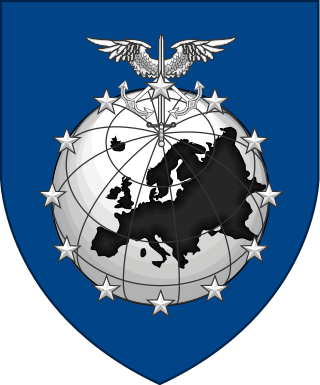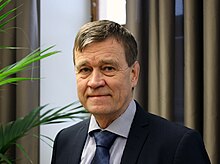
The Political and Security Committee is a permanent body within the European Union dealing with Common Foreign and Security Policy issues,including Common Security and Defence Policy.

The European Union Satellite Centre is the agency of the European Union (EU) that supports the EU's decision-making in the field of the Common Foreign and Security Policy (CFSP),including crisis management missions and operations. It provides products and services resulting from the exploitation of relevant space assets and collateral data,including satellite and aerial imagery,and related services. SatCen is headquartered in the Torrejón Air Base,located in the Spanish municipality of the same name,in the vicinity of Madrid.

The Military Staff of the European Union (EUMS) is the directorate-general of the European Union's (EU) External Action Service (EEAS) that contributes to the EU's Common Security and Defence Policy (CSDP) by providing strategic advice to the High Representative (HR/VP) and commanding operations through its Military Planning and Conduct Capability (MPCC) operational headquarters. From the end of 2020,the MPCC will be capable of running executive operations of up to 2,500 troops,i.e. the size of one EU battle group,as well as 3 non-executive missions.

The Foreign Affairs Council (FAC) is a configuration of the Council of the European Union that convenes once a month. Meetings bring together the foreign ministers of the member states. Ministers responsible for European affairs,defence,development or trade also participate depending on the items on agenda. The configuration is unique in that is chaired by the High Representative of the Union for Foreign Affairs and Security Policy (HR/VP) rather than the member state holding the presidency of the Council of the European Union. There is one exception,when the FAC meets in the configuration of ministers responsible for trade (FAC/Trade),with the presiding member state's minister chairing the meeting.

The Military Committee of the European Union (EUMC) is the body of the European Union's (EU) Common Security and Defence Policy that is composed of member states' Chiefs of Defence (CHOD). These national CHODs are regularly represented in the EUMC in Brussels by their permanent Military Representatives (MilRep),who often are two- or three-star flag officers.
The Committee for Civilian Aspects of Crisis Management,or CIVCOM,is an advisory body within the European Union dealing with civilian aspects of crisis management. The activities of the CIVCOM form part of the Common Foreign and Security Policy (CFSP) of the EU,and the civilian side of the Common Security and Defence Policy (CSDP). The CIVCOM is composed of representatives of the EU member states.

The European Union Operations Centre was an ad-hoc,non-standing,non-commanding headquarters facilitating the planning and conduct of military operations deployed as part of the European Union's (EU) Common Security and Defence Policy (CFSP) that was active between 2012 and 2016.
The EU Intelligence and Situation Centre is a "civilian intelligence function" of the European Union (EU). Structurally,it is a directorate of the External Action Service (EEAS) and reports directly to the EU's High Representative for Foreign Affairs and Security Policy. Article 4 of the Treaty on European Union,among other things,expressly states that "national security remains the sole responsibility of each Member State". EU INTCEN's analytical products are based on intelligence from the EU Member States' intelligence and security services.

The Military Planning and Conduct Capability (MPCC) is a permanent operational headquarters (OHQ) at the military strategic level for military operations of up to 2,500 troops deployed as part of the Common Security and Defence Policy (CSDP) of the European Union (EU) by the end of 2020. Since its inception in 2017,the MPCC has commanded three non-executive training missions in Somalia,Mali and the Central African Republic,and will organise the training of Ukrainian forces on EU soil.

The Director General of the European Union Military Staff (DGEUMS) is the head of the European Union Military Staff (EUMS) who also serves as Director of the Military Planning and Conduct Capability. This position,which was established in 2001,is held by a three-star general. The current holder is lieutenant general Michiel van der Laan,occupying the position since June 2023.

The chairman of the European Union Military Committee (CEUMC) is the four-star rank officer representing and presiding over the European Union's (EU) Military Committee (EUMC),composed of the chiefs of defence (CHODs) of the EU member states. The chairman is selected by the chiefs of defence of the member states and appointed by the members of the Council of the European Union for a three-year term.

The Civilian Planning and Conduct Capability (CPCC) is the directorate of the External Action Service (EEAS) of the European Union (EU) that serves as operational headquarters (OHQ) for the civilian missions of the Common Security and Defence Policy (CSDP).

This article outlines the present structure of the European Union's Common Security and Defence Policy (CSDP),a part of the Common Foreign and Security Policy (CFSP) based on articles 42–46 of the Treaty on European Union (TEU). Article 42.2 of TEU states that the CSDP includes the 'progressive framing' of a common Union defence policy,and will lead to a common defence,when the European Council of national heads of state or government,acting unanimously,so decides.
This article outlines the command and control structure of the European Union's missions,which are deployed as part of the Common Security and Defence Policy (CSDP). This structure ranges from the political strategic level to the tactical level.

The Crisis Management and Planning Directorate (CMPD) is a body within the European Union's (EU) External Action Service (EEAS) that is in charge of the integrated civilian-military planning within the sphere of the Common Security and Defence Policy (CSDP).
The Director of the Civilian Planning and Conduct Capability is the head of the European External Action Service's (EEAS) Civilian Planning and Conduct Capability (CPCC) who also serves as Civilian Operations Commander. The Civ OpCdr exercises command and control at strategic level for the operational planning and conduct of all civilian crisis management missions deployed as part of the European Union's (EU) security and defence policy (CSDP). The Civ OpCdr is assisted by number of senior policy experts.

The Joint Support Coordination Cell (JSCC) is the planned security and defence (CSDP) body of the European Union's (EU) European External Action Service (EEAS) that will provide for relations between the civilian and military planning and conduct capabilities,abbreviated CPCC and MPCC,respectively,in the context of civilian and military missions missions.

The Kortenberg building is an office building of the European Union (EU) in Brussels,Belgium. It houses mostly bodies related to the Common Security and Defence Policy (CSDP).

The European Union (EU) and the North Atlantic Treaty Organisation (NATO) are two main treaty-based Western organisations for cooperation between member states,both headquartered in Brussels,Belgium. Their natures are different and they operate in different spheres:NATO is a purely intergovernmental organisation functioning as a military alliance,which serves to implement article 5 of the North Atlantic Treaty on collective territorial defence. The EU on the other hand is a partly supranational and partly intergovernmental sui generis entity akin to a confederation that entails wider economic and political integration. Unlike NATO,the EU pursues a foreign policy in its own right—based on consensus,and member states have equipped it with tools in the field of defence and crisis management;the Common Security and Defence Policy (CSDP) structure.









